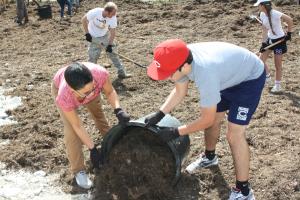Gowanus Curbside Rain Garden
A rain garden, alive with hardy native plants, could bring this Brooklyn street to life and spark an affordable, replicable model of beauty, sustainability, and resiliency.
Leader
Jennifer Bolstad
Location
175 10th Street Brooklyn, NY 11215
Impact areas
About the project
A rain garden, lush with native plants, could transform Gowanus streets. This element of low-cost green infrastructure brings benefits that connect the whole community: cleaner water and air, a feeling of neighborhood stewardship, and natural beauty amid the gray of the area’s industrial streets. Walking under the F train to 4th/9th Street Station, you feel the rumble of the massive, elevated track structure, you see seemingly permanent and barren construction zone under the train, and you feel the heat from a sprawling mess of asphalt. The route is also a hydrological superhighway, transporting polluted stormwater overflows directly into the canal. Flooding wreaks havoc on nearby houses and businesses, and the lack of green creates a bleak streetscape. A linear “tree lawn” runing from Second to Third Avenues along 10th Street is currently cracked and barren. Lifeless, compacted soil is missing plant life that could filter, slow, and cool stormwater. The 675’ strip could transform into an affordable and beautiful piece of green infrastructure, holding over 6000 gallons of rain water temporarily during a storm to reduce flooding, filtering and treating stormwater, offsetting carbon, and creating a community asset. Planted with hardy, local, water-friendly species, the garden will inspire neighbors to care for the streetscape. The garden design will emphasize ease of maintenance, phytoremediation, and natural beauty. With decades of experience designing living infrastructure and landscape, we will create a replicable rain garden model that can inspire other neighborhoods across the city.
The Steps
1. Our staff of skilled landscape architects and designers and will take on a short-term research study to analyze the site, grading, and hydrology, determine the right plant mix and scheme, and develop the planting plan in accordance with City of New York regulations. (1 week)
2. Our staff will author and design educational orientation signage to explain the rain garden to the local community (1-3 days plus printing)
3. With the grant money, we will purchase the tool and materials to complete the project, coordinating delivery and storing the materials. (1-5 days, simultaneous)
4. Our trained staff will implement the rain garden design by grading the “tree lawn”, spreading mulch and planting the native species and following the planting plan. (1 week)
5. Our team, based two blocks away, will maintain and water the garden daily until the plants are established, at which point the garden will only require rain water for irrigation. (2-3 weeks)
Why we‘re doing it
At Local Office, our work centers around supporting coastal resiliency through sustainable landscape design and the support of green infrastructure at all scales, with a focus on New York City. Having worked and lived in Gowanus for eight years, we are never hesitant to roll up our sleeves to support to the neighborhood’s health and vibrancy. This grant would allow us to realize our dream of greening 10th Street while contributing to the professional research on urban green infrastructure, results that will help neighborhoods across the city and country.
Improved air and water quality and community stewardship impact each and every resident and worker in Gowanus. And the whole city connects directly to Gowanus through our waterways. Stormwater runoff pollution is a serious challenge to New York City’s safety, sustainability, and resilience. This project would go toward improving water quality and our understanding of how to implement water remediation gardens city-wide. Beyond the benefits to water and air, green spaces also contribute to a neighborhood’s social connectivity and mental health. Increasing green space coverage is part of city-wide goals for environmental protection and stewardship. Research and pilot project implementation funded through this grant can help improve the ways that the city approaches its stormwater management with green infrastructure.

